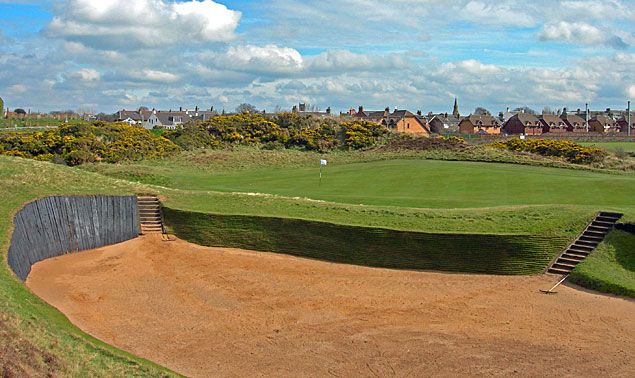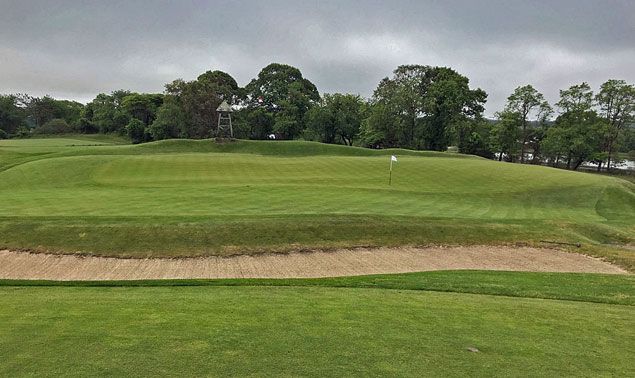A is for ALPS
THE ORIGINAL
Prestwick Golf Club—originator of several templates—claims “Alps” is “the oldest existing hole in championship golf.” It played as No. 2 during the first Open, and although course routing has changed (it’s now No. 17), the par four plays almost identically to its initial purpose.

Prestwick 17th hole - Alps
The opening drive is to a relatively narrow fairway for the links, but the true nature of the “Alps” becomes evident upon the approach shot. The namesake “mountains” block any view of the green, forcing the player to calculate an ideal distance to the flagstick (the position of which is displayed at the tee). The green is large and its Punchbowl form is forgiving; it shows mercy on blind players by funnelling reasonable approach shots toward the centre. Missing the outskirts of the green is not an option, however. Aside from the tall fescue surrounding, the green is fronted by the notorious railway-sleepered and sod-faced “Sahara” bunker (there was, presumably, no Swiss desert to name it after).
The original comes from the drawing board of Old Tom Morris (considered by Darwin as "the most spectacular blind hole in all the world") but again C.B. Macdonald has come to define it. In his writings, he described Alps as featuring total blindness on the second shot—both the bunker and green totally obscured. The player then hits his shot over the Alps to a green that “lies in a hollow with the bunker in front and a high bank behind,” a “high shot with a long carry and very little run.”
OTHER INTERPRETATIONS
Macdonald notably made no notes about fairway requirements, and this is evident in his most acclaimed iteration, No. 3, the Alps at National Golf Links of America. Rather than playing dead ahead, the fairway moves diagonally from left-to-right; the farther left a player leaves their tee shot, the higher they must play to clear the hill. Although the fairway rises in altitude as it travels right, players must reckon with a long bunker along the right edge, to test the nerves. The rules of approach remain true: A deep and lengthy cross-bunker guards the apron surrounding an enormous, bowled green.

National Golf Links of America 3rd hole - Alps
As with all templates, especially one with as many constituent components as Alps, some flexibility has been accepted. Seth Raynor ran into a wall at Yeamans Hall, where membership outright told the Macdonald acolyte that they had no interest in blind shots. And so he did his best at No. 5 to (partially) block the approach view with a high-humped fairway bunker, and made up for the relative lack of blindness by adding more challenge to the green.
Raynor would later refer to “Alps bunkering” to mean large, green-fronting cross-bunkers...no hill required. On the other hand, he cut out the cross-bunker requirement altogether for his famous Alps at Fishers Island. No stranger to manipulating earth, Raynor created a Punchbowl (when the island wouldn’t offer one) by raising a quarter-pipe ramp around the green.
The trend away from blind shots has made Alps an increasingly rare guest in modern designs, however. Tom Doak and Jim Urbina's Old Macdonald—a tribute to C.B.—features a self-described Alps, but David McLay Kidd’s No. 10 at Bandon Dunes could pass muster if you accept the lack of cross-bunkering.
MAYBE... MAYBE NOT
The Raynor and Banks version at Lookout Mountain features an interesting—and controversial—Alps interpretation at its eleventh hole. The approach shot is most certainly blind, but it plays downhill and will allow a well-placed run-up. More thought-provoking is the supposed “Sahara” bunker, which lurks at the back right of the green, rather than the front. Considering Prestwick’s relative emphasis on accuracy of distance over accuracy of direction, this bunker’s role within the template is suspect, especially with the lack of a Punchbowl green.
Some cite Lahinch’s short par five No. 4 Klondyke as an Alps, which is an overstatement. Although there is nothing preventing a par five from being an Alps, the Klondyke dune sits more than 150 yards (at its peak) from the hole, and features in front of a particularly wide stretch of fairway. This safe zone—versus a forced carry—derails the Alps comparisons. A more likely candidate would be the No. 13 “Nemesis” hole at Tobacco Road, where the third shot must clear two heavily-bunkered sand mounds to reach the green. Even then, the relative absence of depth to the green makes it a problematic “Alps” at best.
Although Macdonald’s rules for the Alps don’t necessarily count out the idea of a par three, other blind-shot shorts—such as Maiden and Dell—typically fill that void.
